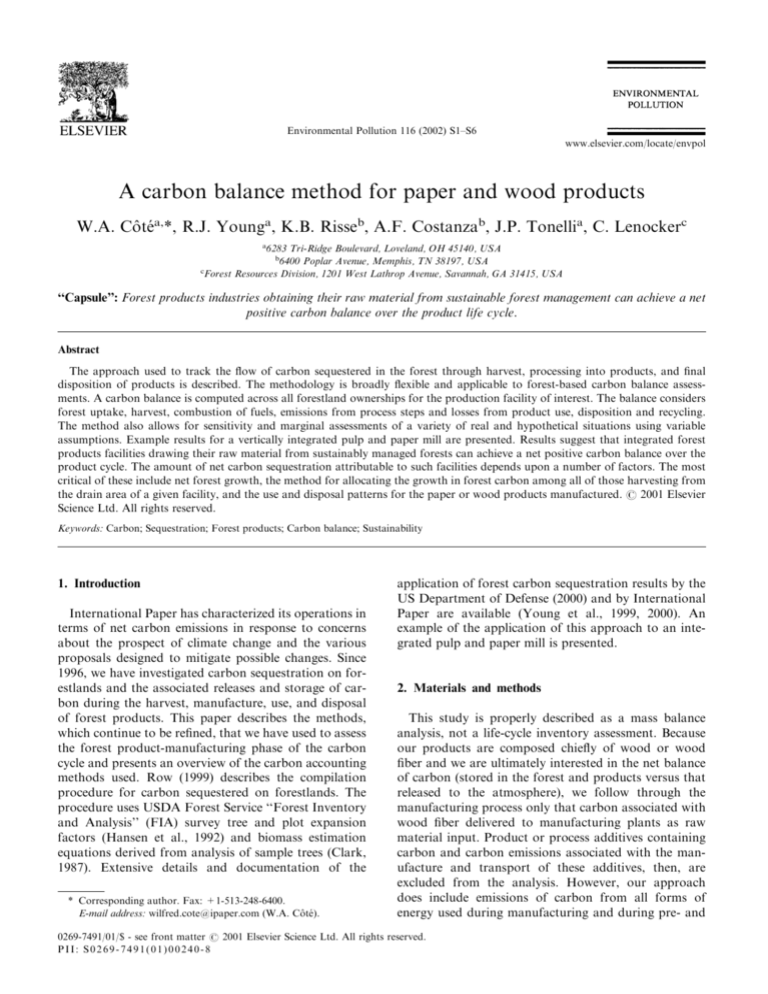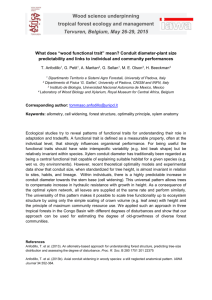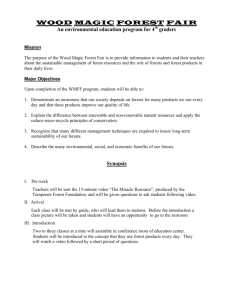
Environmental Pollution 116 (2002) S1–S6
www.elsevier.com/locate/envpol
A carbon balance method for paper and wood products
W.A. Côtéa,*, R.J. Younga, K.B. Risseb, A.F. Costanzab, J.P. Tonellia, C. Lenockerc
a
6283 Tri-Ridge Boulevard, Loveland, OH 45140, USA
b
6400 Poplar Avenue, Memphis, TN 38197, USA
c
Forest Resources Division, 1201 West Lathrop Avenue, Savannah, GA 31415, USA
‘‘Capsule’’: Forest products industries obtaining their raw material from sustainable forest management can achieve a net
positive carbon balance over the product life cycle.
Abstract
The approach used to track the flow of carbon sequestered in the forest through harvest, processing into products, and final
disposition of products is described. The methodology is broadly flexible and applicable to forest-based carbon balance assessments. A carbon balance is computed across all forestland ownerships for the production facility of interest. The balance considers
forest uptake, harvest, combustion of fuels, emissions from process steps and losses from product use, disposition and recycling.
The method also allows for sensitivity and marginal assessments of a variety of real and hypothetical situations using variable
assumptions. Example results for a vertically integrated pulp and paper mill are presented. Results suggest that integrated forest
products facilities drawing their raw material from sustainably managed forests can achieve a net positive carbon balance over the
product cycle. The amount of net carbon sequestration attributable to such facilities depends upon a number of factors. The most
critical of these include net forest growth, the method for allocating the growth in forest carbon among all of those harvesting from
the drain area of a given facility, and the use and disposal patterns for the paper or wood products manufactured. # 2001 Elsevier
Science Ltd. All rights reserved.
Keywords: Carbon; Sequestration; Forest products; Carbon balance; Sustainability
1. Introduction
International Paper has characterized its operations in
terms of net carbon emissions in response to concerns
about the prospect of climate change and the various
proposals designed to mitigate possible changes. Since
1996, we have investigated carbon sequestration on forestlands and the associated releases and storage of carbon during the harvest, manufacture, use, and disposal
of forest products. This paper describes the methods,
which continue to be refined, that we have used to assess
the forest product-manufacturing phase of the carbon
cycle and presents an overview of the carbon accounting
methods used. Row (1999) describes the compilation
procedure for carbon sequestered on forestlands. The
procedure uses USDA Forest Service ‘‘Forest Inventory
and Analysis’’ (FIA) survey tree and plot expansion
factors (Hansen et al., 1992) and biomass estimation
equations derived from analysis of sample trees (Clark,
1987). Extensive details and documentation of the
* Corresponding author. Fax: +1-513-248-6400.
E-mail address: wilfred.cote@ipaper.com (W.A. Côté).
application of forest carbon sequestration results by the
US Department of Defense (2000) and by International
Paper are available (Young et al., 1999, 2000). An
example of the application of this approach to an integrated pulp and paper mill is presented.
2. Materials and methods
This study is properly described as a mass balance
analysis, not a life-cycle inventory assessment. Because
our products are composed chiefly of wood or wood
fiber and we are ultimately interested in the net balance
of carbon (stored in the forest and products versus that
released to the atmosphere), we follow through the
manufacturing process only that carbon associated with
wood fiber delivered to manufacturing plants as raw
material input. Product or process additives containing
carbon and carbon emissions associated with the manufacture and transport of these additives, then, are
excluded from the analysis. However, our approach
does include emissions of carbon from all forms of
energy used during manufacturing and during pre- and
0269-7491/01/$ - see front matter # 2001 Elsevier Science Ltd. All rights reserved.
PII: S0269-7491(01)00240-8
S2
W.A. Côté et al. / Environmental Pollution 116 (2002) S1–S6
post-manufacturing phases. The data gathering process
describing the flow and storage of carbon in the manufacture of wood products begins with carbon (wood
fiber) at the plant gate and ends with product ready for
shipment to the marketplace. Plant records of wood
purchased and product shipped are considered accurate
for the purpose of this analysis. Using these two values,
in bone dry tons, as fixed end points, intermediate process steps are characterized in terms of energy use,
emissions of carbon, and process efficiency using normal
operating data. These data have more error associated
with them than wood purchasing and product shipment
records; this is particularly true for the amounts of bark
burned and black liquor processed, for instance, that
have variable moisture contents. Where necessary, an
adjustment factor is applied to process statistics to bring
the carbon-in-product value into agreement with the
computed value for carbon in incoming raw material.
These adjustments have been minor in this example.
Our in-mill model begins with facility-specific records
for the purchase of wood fiber (roundwood, chips, or
wood residuals). In each case, we back-calculate wood
values to whole tree carbon values using a biomass utilization rate based on FIA data. The utilization rate is
the ratio of total tree carbon to the carbon in merchantable trees harvested within the region, or ‘‘drain area’’,
from which a facility obtains its wood fiber, during the
most recent FIA plot remeasurement period. Total tree
biomass includes estimates for roots; these estimates are
derived using data developed by Koch (1989). The
merchantable biomass is further described in Hansen et
al. (1992). Whole tree values (total tree biomass converted to Metric Ton Carbon Equivalent [MTCE] units)
are the basis for estimating the percentage of the total
annual tree harvest in the drain area that is used by that
facility.
Input raw material, final product, and intermediate
process step and emission data are generally reported as
US tons. These are converted to metric tons and adjusted for moisture content where appropriate. Loss rates
due to processing are either as reported by the facility,
from literature, or estimated to allow the overall process
flow to balance. Algorithms were built into the model to
check the relative error of each input. The data were
checked against a theoretical process flow based on
measurable process inputs and outputs. As calculated,
the estimated error was checked against a table of
acceptable errors, and any discrepancies halted the
model operation. Maximum allowable error was limited
to 10% for paper mills; the largest absolute error value
was 2.5% for the mill discussed here. This internal
checking technique added an additional layer of data
verification to the model and provided valuable information regarding the accuracy of data gathered. Process
absolute error values were then used to provide the
necessary information for calculating upper and lower
limits on sequestration ratios through the use of a
Monte Carlo simulator.
Pulp and paper manufacturing is a complex, energyintensive process that separates wood fibers from one
another so they can be used to make paper products.
The pulping process used to separate fibers dissolves the
lignin, a natural glue that holds the fibers together.
The dissolved lignin and other wood components are
burned to recover pulping chemicals and capture heat
energy, which is then used to drive the pulping process.
It is this dual use of wood for fiber and chemical energy
that makes papermaking an economically sustainable
enterprise.
Wood processing for pulp production results in ‘‘yield
losses’’ that are facility-specific and generally are 50–
55% by weight of the wood used as a raw material. This
is largely due to extraction of lignin and other organics
from wood chips in the digester. Approximately 4% by
weight of the input wood is captured as turpentine and
soap. These chemical by-products are treated as shortlived and are counted as emissions. The remaining pulp
yield loss is assumed to be emitted as CO2 from combustion of black liquor in the recovery boiler.
The chemical recovery system employs lime, CaO, in
rejuvenating pulping chemicals. During this process the
lime is converted to CaCO3 (‘‘lime mud’’). The carbon
dioxide captured in the lime mud originates from the
carbon in the wood fibers. When the mud is recalcined
in the lime kiln to provide lime for the recovery cycle,
this CO2 is released. The only additional, or new, carbon emission during the recalcining process is associated with the fossil fuel used. This distinction is
important when categorizing carbon emissions as originating from wood or fossil fuel. The total biofuel carbon value from the recovery boiler (black liquor
burning) and the lime kiln, together with the carbon
value of turpentine and soap, is equivalent to the yield
loss across the digester.
Bleaching pulp to brighten it removes additional lignin and results in a weight loss of 4–8% across the
bleach plant. This carbon is sewered and assumed to go
to atmosphere via biological activity at the wastewater
treatment plant.
Mills that utilize recovered paper for papermaking
experience yield losses of fiber from about 16% for
linerboard (unbleached) to 18% for bleached paper.
This lost fiber is burned, degraded in wastewater treatment systems, or landfilled, but, regardless of its fate, we
assumed that it is emitted to atmosphere in the year of
production, a conservative assumption. Where we use
recycled fiber, we consider only the emissions associated
with repulping losses, energy requirements for processing the fiber and making product, and post-use disposal of products. We do not consider carbon costs or
credits associated with the production of virgin fiber
that is recovered for recycling.
W.A. Côté et al. / Environmental Pollution 116 (2002) S1–S6
Figures for product shipped to market are adjusted to
account for final product moisture, fillers, and coatings.
The fate of these products after use will contribute to the
total emission of carbon associated with the products.
Figures that characterize product fate, including the
proportions of products recycled, landfilled, or burned,
are estimated following procedures developed by Row
and Phelps (1991, 1996) and refined by Skog and
Nicholson (1996) and Heath et al. (1996). Decay rates
and emissions for landfilled products are projected from
the results of an extensive study of the emissions of
greenhouse gases from the management of solid waste
(US EPA, 1998) and from a study of the disposition of
forest products (Micales and Skog, 1997) and are included in emission totals.
Once the basic mass balance for wood (merchantable
and nonmerchantable tree biomass), wood fiber, and
products has been completed, carbon factors from the
literature are applied to input wood fiber and the various outputs and losses to convert bone dry tons of fiber
to their carbon equivalents. These values are then
available for computation of net sequestration ratios.
The sequestration ratio (mass of carbon sequestered/
mass of carbon emitted) considers carbon storage and
release in a chosen year. For this study, the year 1998
was used since it was the latest year for which all
required data were available; there was no attempt to
select a specific, optimal year. The estimate of total carbon sequestered as biomass (wood) in the drain area of
a given facility that uses wood as its basic raw material
is compared to the total releases of carbon associated
with the growing, maintenance, harvest, and transport
of wood to the mill and the manufacture, use, and disposal of the forest products from the facility. Ratios
greater than 1.0 indicate that more atmospheric carbon
is being stored in new wood and wood products than is
released from the processing and use of the wood in the
manufacture of products by the facility in question. A
ratio of less than 1.0 indicates carbon emissions to
atmosphere exceed the sequestration of carbon by photosynthesis in the selected year and that the net result of
the forest management, manufacturing, and product use
and disposal cycle was emission of carbon dioxide to the
atmosphere for that period. A potentially important
component of the total carbon sequestration balance,
soil carbon, has been omitted in this analysis. There is
much current research on the role of forest management
on soil carbon dynamics and storage potential, but for
the purpose of this assessment we assumed carbon storage in the soil to exhibit no net change over normal
harvest cycles.
The carbon balance model we developed enables us to
consider 16 different carbon accounting scenarios,
which range from conservative to liberal treatment of
emissions and sequestered carbon based on the
assumptions or combination of assumptions used in the
S3
analysis. Assumptions fall into three categories. The
first category offers two approaches to ‘‘crediting’’
sequestered carbon. One scenario counts only net forest
growth as sequestered carbon. The second adds other
possible carbon ‘‘sinks’’ to the carbon sequestered in
new wood, such as paper that is considered permanently
entombed in landfills and that will not decompose, to
the carbon sequestered in new wood.
The second category of assumptions addresses carbon
emissions accounting for fuel usage. In ‘‘full accounting’’, all emissions from combustion of fuel are counted,
regardless of fuel type. In ‘‘Kyoto accounting’’, only
emissions from fossil fuels are counted. This scenario
follows accounting rules in the Kyoto Protocol and does
not count emissions from use of biofuels or those from
fossil fuels used to produce purchased electricity (which
are assigned to the generating utility under the industry
segment approach).
The last category of assumptions deals with inputs to
the model. These assumptions allow the user to choose
the ‘‘best’’ data for calculations. For example, biofuel
usage can be based on figures reported by the mill or on
averages derived from published data. Process efficiencies can be those reported by the mill or as calculated based on material flows through the process.
Changes to assumptions in this category will have less
effect on sequestration estimates than changes in selections in the other two categories. The eight sets of
assumptions from the three categories can be used in
any combination to give the user full control over model
calculations.
3. Results
The analysis conducted for our Texarkana, Texas mill
provides a comprehensive example of the methodology
used. This mill is an integrated facility that produces
virgin bleached board and cupstock grades of paper
from pulp produced at the same site. Rolls of product
are shipped to other locations for conversion into milk
and juice cartons and a variety of paper cups. This is a
large mill; in 1998, this mill manufactured 556,715 bone
dry tons of product from 1.3 million bone dry tons of
wood (59% hardwood and 41% softwood). As a
bleached mill, Texarkana uses more energy per ton of
pulp than mills without bleaching, making its carbon
balance less favorable. The Texarkana mill operates two
large power boilers and two large recovery boilers. The
energy used to run the facility in 1998 included biofuels
(bark and black liquor), oil, natural gas, electricity, and
propane (to power on-site vehicles such as lift trucks).
The mill receives roundwood and wood chips from
approximately 75 counties in Texas, Arkansas, Louisiana, and Oklahoma. This drain area fixed approximately 35 million tons of carbon in 1998, of which 10.6
S4
W.A. Côté et al. / Environmental Pollution 116 (2002) S1–S6
Fig. 1. Energy and material flows as carbon (M metric tons), Texarkana mill, 1998.
million tons were harvested. On a unit area basis, this
growth represents about 4.28 metric tons of carbon fixed
per hectare for the overall mill drain area in 1998. Carbon
fixed per hectare in 1998 for company drain areas ranged
from 6.00 to 0.50 and averaged 3.68 metric tons; both the
high and low fixation rates occurred in Mississippi.
Following accounting procedures described previously, all system carbon flows for the Texarkana mill
are depicted in Fig. 1. Carbon emissions associated with
the operation of the Texarkana mill, forest management
in the associated wood drain area for all owners, and
use and disposal of its products are summarized in
Table 1. Emission and whole tree factors used in this
assessment continue to be refined. These improvements
will alter the carbon emission values reported here, but
any such changes should be minor and not change the
relative contributions of various sources and activities
to total emissions. Sensitivity analysis results show that
for 1998 the Texarkana mill had sequestration ratios
greater than 1 for all possible scenarios and after taking
the estimated error within the model to extreme values.
Note that Pulping loss (recovery) is the highest single
category of non-fossil fuel emissions. This is consistent
with the importance of chemical energy recovery processes to the economics of pulping. Slash and root decay
is the second largest category of non-fossil fuel emissions. This value is highly sensitive to the total tree factor used to estimate the additional non-merchantable
volume of wood in tops, branches, and roots as well as
to the utilization of the merchantable portion of trees
for either solid wood products or pulp and paper. The
category designated Product loss (collection) represents
losses of product during collection and processing for
disposal or recycling. Pulping loss (recovery), the largest
single contribution to the mill total at 44.9% of total
emissions, includes emissions from fossil fuel usage
elsewhere in the manufacturing process that cannot be
otherwise allocated because details of use are not recorded. The total emissions of the smallest eight categories
of emissions are about 72% of those from Pulping loss
(recovery). Fossil fuel emissions are approximately
23.0% of all emissions.
W.A. Côté et al. / Environmental Pollution 116 (2002) S1–S6
Table 1
1998 Emissions (M metric tons carbon)
Fossil Decay Biofuel Total
fuel
burning emissions
Timber growth
30
Fuel for tree harvest
44
Slash and root decay
Bark and waste
3
Pulping loss (recovery)
126
Bleaching loss
14
Product loss (collection)
Product incineration for energy
6
Landfill greenhouse gas emissions
Silvichemicals produced
Adjustment
Total
223
223
29
58
311
24
23
29
15
3
340
30
11
410
30
44
223
90
437
38
23
36
40
15
3
973
Table 2
Sequestration results Texarkana Mill
Accounting method
Sequestration ratio
Net growth only
(full emission debit)
Net growth only
(Kyoto accounting)
All sequestration credits
(full emission debit)
All sequestration credits
(Kyoto accounting)
1.38
2.54
1.55
2.81
Table 2 presents both the most conservative and most
generous sequestration results for the Texarkana mill.
All other scenarios resulted in intermediate sequestration ratios. When the most conservative set of assumptions is applied to this mill, the computed sequestration
ratio of 1.38 indicates that more carbon is fixed in new
wood grown in the drain area for the mill than is emitted from all forest management, manufacturing, and
product use and disposal options associated with the
mill. The sequestration ratio approaches 3.0 using more
generous but still reasonable assumptions.
4. Discussion
Due to the nature of the data used in this model, some
error will inevitably be introduced. To address this
issue, we have incorporated a sensitivity analysis
method that relies on Monte Carlo simulations to estimate ranges of possible results. Each input variable to
the model is assigned an error that is equal to the total
error for that particular set of processes. For example,
the process of pulping wood chips yields wood pulp,
byproducts of soap and turpentine, and spent cooking
chemicals (black liquor) that include lignin extracted
from the wood. The amount lost should simply be the
input minus the output, which can then be converted
S5
into a percentage loss. However, pulping loss may be
measured independently of the mass throughput of the
process, and this can lead to discrepancies in the
amounts reported to be lost through the process. The
sensitivity analysis portion of the model looks at the
total amount of error introduced by this discrepancy
and uses it to set an upper and lower boundary for the
input variable. Each input variable now has four attributes that are used to better estimate the true value of
any given variable. These attributes are:
1.
2.
3.
4.
Reported value;
Estimated absolute process error;
Upper limit for reported value; and
Lower limit for reported value.
These statistical data are used by the simulator to
randomly choose a value that falls within the upper and
lower limits for the reported value based on a normal
curve of possible values. Each reported value is then
changed to this randomly generated number and put
back into the overall model to recalculate the sequestration. This is done 10,000 times for every input value
used in the model (up to 48) and each recalculation is
performed independently of the next. The result is a
range of possible sequestration ratios for each of the 16
scenarios that capture the possible sequestration ratios
based on the absolute process error.
When this analysis is applied to the Texarkana model,
it shows that this mill sequesters carbon even under the
worst scenarios and conditions. Based on the estimated
error, the sensitivity analysis shows that under the most
conservative scenario Texarkana sequestered at least
400 t of carbon in 1998 and up to 1000 tons. This tool
allows us to ensure that a particular facility is sequestering carbon regardless of the scenario chosen or the
error induced by reported values.
Sequestration ratios for the Texarkana mill are
greater than 1.0 for even the most conservative scenario.
These ratios depend on two significant factors. The first
is the fact that the forests in the drain area of this mill
have high growth rates and hence fix large amounts of
carbon in new wood. In addition, International Paper
utilizes a large fraction of the harvest within the drain
area. Based on the methods used in this analysis to
allocate this growth among those using the forest harvest, a large portion of the growth is assigned to the
Texarkana mill. This large sequestration value is
responsible for high sequestration ratios.
The conditions in the drain area of the Texarkana mill
do not necessarily apply to all other integrated mills.
Greater or lesser demands on the fiber resources of a
mill drain area will impact the net annual growth, as
will a history of catastrophic events such as storms,
insect infestations, and disease outbreaks that can
reduce the volume of standing stock and the vitality of
surviving trees. Under such conditions, net forest
S6
W.A. Côté et al. / Environmental Pollution 116 (2002) S1–S6
sequestration may not exceed carbon emissions, resulting in sequestration ratios of less than 1. What the
results for the Texarkana mill do demonstrate, however,
is that modern integrated paper mills relying on sustainably managed forests for their fiber can be net
sequesterers of carbon.
5. Conclusions
Techniques such as those described here can be used
to develop acceptable estimates of carbon stocks and
flows. Reasonable carbon sequestration-to-emission
ratios can be derived from these estimates. Sequestration ratios that reveal significantly greater storage than
release of carbon, as in the example given here, demonstrate that the forest products industry can be environmentally sustainable using current practices. Future
developments in forest management methods and manufacturing processes that improve forest growth and
process efficiencies should further enhance this sustainability.
Acknowledgements
This assessment would not have been possible without
the contributions of Dr. Clark Row, of Row Associates,
who developed and applied the refined methods used to
estimate forest growth used in this study. This paper
was presented at the USDA Forest Service Southern
Global Change Program sponsored Advances in Terrestrial Ecosystem: Carbon Inventory, Measurements,
and Monitoring Conference held 3–5 October 2000 in
Raleigh, North Carolina.
References
Clark III., A., 1987. Summary of biomass equations available for
softwood and hardwood species in the southern United States. In:
Estimating Tree Biomass Regressions and Their Error. USDA
Forest Service, Northeastern Forest Experiment Station.
Hansen, M.H., Frieswyk, T., Glover, J.F., Kelly, J.F., 1992. The
Eastwide Forest Inventory Data Base: Users Manual (General
Technical Report GTR-NC-151). USDA Forest Service, North
Central Forest Experiment Station.
Heath, L.S., Birdsey, R.A., Row, C., Plantinga, A.J. In: Apps, M.,
Price, D. (Eds.), Forest Ecosystems, Forest Management, and the
Global Carbon Cycle, NATO Series Vol. I 40. Springer-Verlag,
Berlin, pp. 271–278.
Koch, P., 1989. Estimates by Species Group and Region in the USA
of: I. Below-ground Root Weight as a Percentage of Ovendry
Complete-tree Weight; and II. Carbon Content of Tree Portions
(Consulting Report to USDA Forest Service, available from R.A.
Birdsey, USDA Forest Service, Northeast Forest Experiment Station, Newtown Square, PA).
Micales, J.A., Skog, K.E., 1997. The disposition of forest products in
landfills. International Biodeterioration and Degradation 39 (1-3),
145–158.
Row, C., 1999. Measurement of forest carbon: direct and indirect
approaches. In: Proceedings of 1999 NCASI Central-Lake States
Regional Meeting. National Council for Air and Stream Improvement, Research Triangle Park, NC, pp. 195–203.
Row, C., Phelps, R.B., 1991. Carbon cycle impacts of future forest
products utilization and recycling trends. In: Agriculture in a World
of Change. Proceedings of Outlook ’91. US Department of Agriculture, pp. 461–468.
Row, C., Phelps, R.B., 1996. Wood carbon flows and storage after
timber harvest. In: Sampson, R.N., Hair, D. (Eds.), Forests and
Global Change, Vol. 2: Forest Management Opportunities for
Mitigating Carbon Emissions. American Forests, Washington, DC,
pp. 59–90.
Skog, K.E., Nicholson, G.A., 1996. Carbon cycling through wood
products: the role of wood and paper products in carbon sequestration. Forest Products Journal 48, 75–83.
US Department of Defense, 2000. Department of Defense Inventory
of Greenhouse Gas Emissions and Sinks, 1990 and 1996 (Final
Report Contract No. N00174-96-D-0001/0052). ICF Consulting,
Inc., Washington, DC.
US Environmental Protection Agency (US EPA), 1998. Greenhouse
Gas Emissions from Management of Selected Materials in Solid
Waste (Final Report EPA 68-W6-0029). US EPA Office of Solid
Waste and Office of Policy.
Young, R.J., Tonelli, J.P., Côté, W.A., Row, C., 1999. A study of net
carbon sequestration at integrated pulp and paper mills. International Paper, Cincinnati.
Young, R.J., Row, C., Tonelli, J.P., Côté, W.A., Lenocker, C., 2000.
Carbon sequestration and paper: a carbon balance assessment.
Journal of Forestry 98 (9), 38–43.








